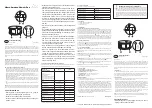
Operation & Service Manual
Section IV
Model 1805B RF Control Unit
Testing
• Connect a 10-dB attenuator (such as the Weinschel Model 44-10) to the RF output of the
thermistor mount (on the 1109, link the attenuator to its test port; on the 1807A, link the
attenuator to its front panel TEST PORT J5).
• Connect the opposite end of the 10-dB attenuator to the input of a power sensor head
(such* as the Hewlett-Packard 8481 A).
• Connect the output of the power sensor head to a power meter.
• If desired, bus the frequency source, amplifier, power meter, and the 1805B to an IEEE-
488 bus controller and control the procedure remotely. If desired, connect a printer to the bus
controller to obtain a hard copy of the dc substituted power and frequency levels at which
variances in the stability test occurs.
b. Place all Test Equipment Power switches to ON. Allow for a 3-24 hour warm-up period
for the Feedthrough Power Standard and Power Meter to Stabilize.
c. Zero and calibrate the power meter and sensor.
d. Set the Signal generator to a desired frequency. For example, if using a F 1109, select a
frequency between 0.01 and 18 GHz.
e.
S
et the dc substituted power level of the Model 1805B according to the value of
P
in
Table 4-2.
f. Wait for stabilization and then take 10 random power readings in a one-minute time
period and record results.
Table 4-2 dc Substituted Power Setttings
g. Verify that all power readings are within ± 3
μ
W. If YES, repeat step for all power
levels listed in Table 4-2.
CONTACTING TEGAM
Do NOT return any instrument or component to the factory without prior authorization. When
an instrument or component has to be returned to the factory. Section I provides the necessary
information to contact and return the instrument or component to TEGAM.
4-
8









































